Terrier Time
I thought it was time to turn my attentions to one of the excellent O Gauge Terriers. So here we have one In BR Black #32636.
Weathering steam locomotives is always a subjective topic, too dirty, too clean and of course what time period do you want to reproduce? I remember steam from the late sixties and they were utterly filthy. However this is often too much for most modellers / collectors so I aim to reproduce a loco that has been maintained, has worked hard but seen “better days”.
Equipment
The Neo for Iwata CN was used for the main part of this exercise, as the needle & nozzle are 0.35mm which delivers a delicate touch, the Sparmax MAX-4 being used for the frames and the varnish coats as the larger nozzle gives wider coverage.
Paint
I prefer to use enamels by Phoenix paints with a touch of Humbrol, and powders by MIG and Wilder. Although acrylics are fine if that is your preference. As usual I will be thinning the enamel paint with cellulose, but thinners are fine and a “must” for use with varnish.
A little on the subject of mixing paint, mixing is achieved by use of either a metal stirrer by hand or an electric one produced by Badger, in both cases I add the paint to my mixing jar and then thin the solution until I can get 2 drops of the end of my stirring device, the consistency has been likened to “green top milk” in the past.
In the interests of safety please always remember to wear a face mask when spraying, even if you are outside.
Items Used
Airbrushes - Neo for Iwata CN; Sparmax MAX-4
Compressor - Sparmax Zeta with Smart-Stop Hanger
Phoenix Paints – Frame Dirt, Sleeper Grime, Roof Dirt, Dull Black, Matt and Satin Varnish to finish (#P960, #P961, #P962, #P981, #PV82, #PV72).
Humbrol Paint – Leather, Matt Black and Tank Grey (#62, #33, #67).
Mig Washes – Oil & Grease Mixture
Mig / Wilder Powders – Black Smoke, Aged Rust.
Humbrol Maskol, Tamiya Masking Tape.
Contacts/Suppliers
The airbrush company: https://www.airbrushes.com/ tel. +44 (0)1903 767 800.
They are the UK import agents for Neo, Sparmax and Iwata airbrushes & / or compressors and are highly recommended.
Phoenix Paints: http://www.phoenix-paints.co.uk/ tel. +44 (0) 1268 730549.
Humbrol, and MIG / Wilder products can be found at good model shops or at suppliers I have used in the past who offer a good reliable service:
The airbrush company: https://www.airbrushes.com/ tel. +44 (0)1903 767 800.
SnM stuff: http://www.snmstuff.co.uk/ tel. +44 (0)1252 540 894.
Creative Models: http://www.creativemodels.co.uk/ tel. +44 (0) 1354 760022.
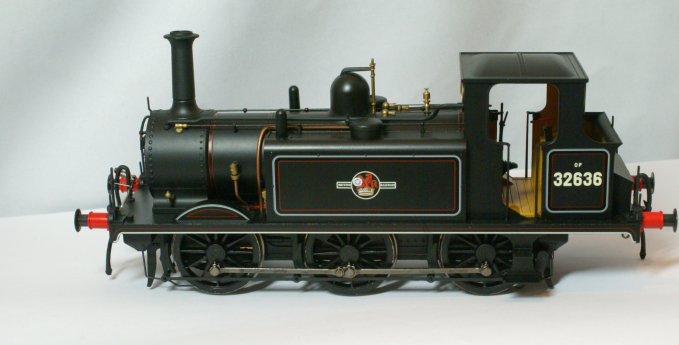
1) The loco straight out of the box, very clean with a satin finish.
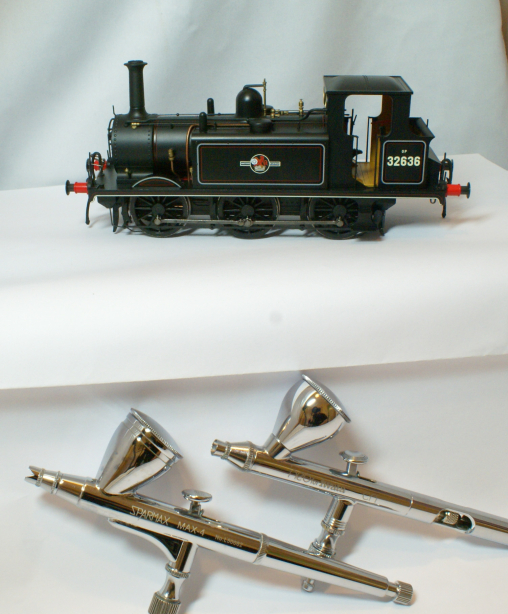
2) The untouched loco with the airbrushes used.
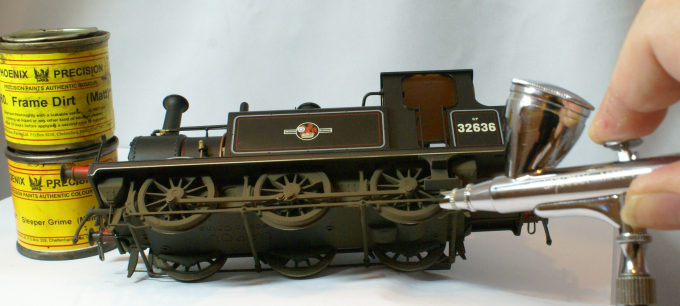
3) The paint mix for the frames was Phoenix Frame Dirt with a touch of Sleeper Grime to add variation. I got in close with the Sparmax to ensure good coverage making sure all of the wheels were fully coated with paint. Once the spraying is complete and the paint has dried, (allow 24 hours) Mig & Wilder weathering powder - Black Smoke and Aged Rust - are used to pick out the springs and suspension.
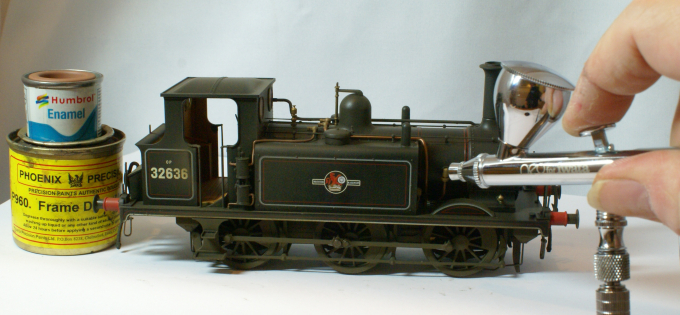
4) The loco body is next, once the windows are masked off, using Humbrol Maskol, to ensure they are not “fogged” by the spray, a 60/40 mixture of Phoenix Frame Dirt & Humbrol Matt Leather is “misted” onto the loco, using the Neo at a low pressure, this enables a constant graduated tone to be achieved, until the desired effect is achieved.
Once dry, the loco is treated to a mist of a Humbrol Tank Grey mixed with Phoenix Roof Dirt (70/30 mixture) with particular attention being made to the footplate. The loco buffers are then given a “splodge” of oil & grease mixture using a small round brush.
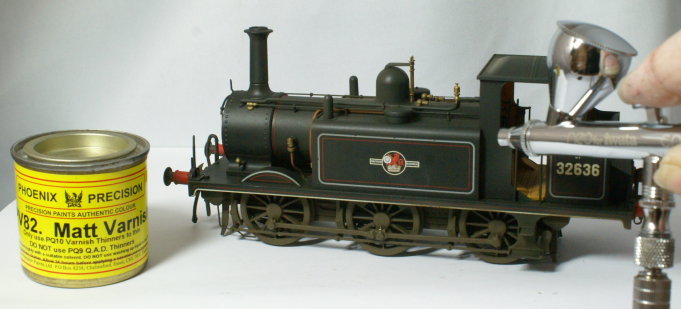
5) The loco is left to dry for a further 24 hours before receiving a coat of matt varnish to seal in the weathering powder and paint. The loco is then left for another 24 hours for everything to harden.
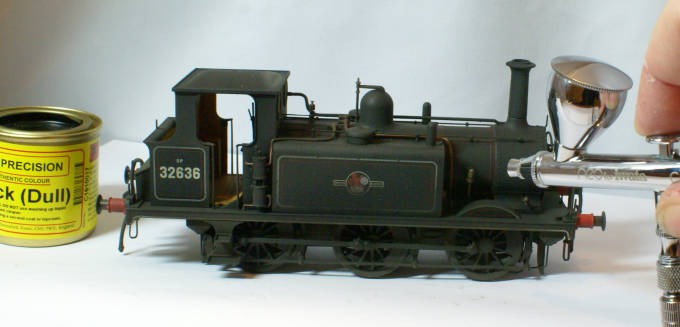
6) A light spray of Phoenix Dull Black is finally used to blend all the elements together & darken the smokebox.
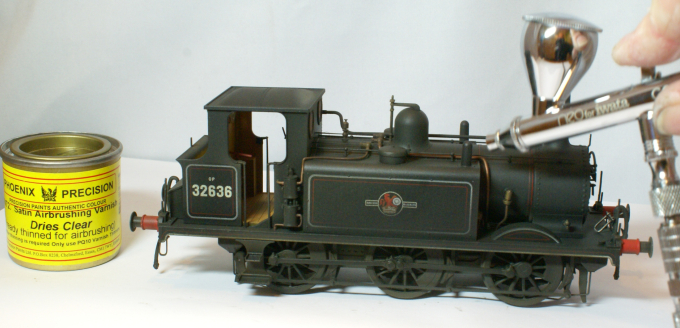
7) Once all is dry and the paint has hardened, the loco is given a complete coat of satin varnish using the Sparmax. Please note that Phoenix varnish should always be diluted with Varnish Thinners to achieve the best results, however it can be purchased ready thinned for spraying.
Once the varnish has hardened the loco is checked for flaws and if found rectified, here the Neo scores well as the cup size is interchangeable, the wheel treads are then cleaned and the motor tested.
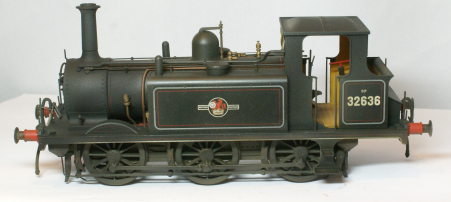
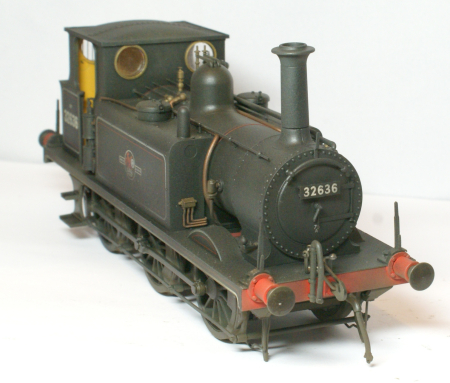
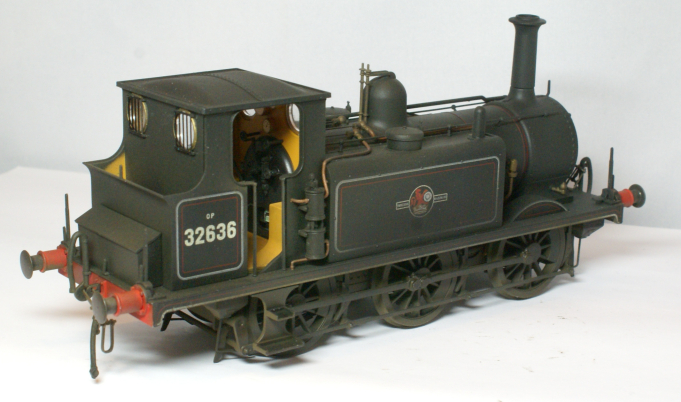
8-10) The finished loco.
